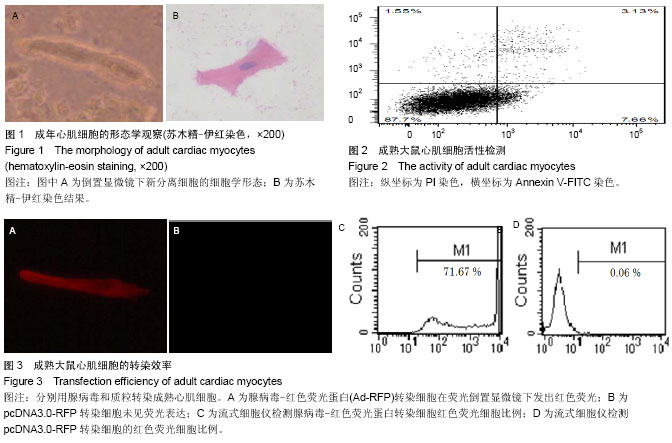| [1] Alhabib KF, Elasfar AA, Alfaleh H,et al.Clinical features, management, and short- and long-term outcomes of patients with acute decompensated heart failure: phase I results of the HEARTS database. Eur J Heart Fail. 2014.
[2] Aresti NA, Malik AA, Ihsan KM, et al. Perioperative management of cardiac disease.J Perioper Pract. 2014; 24(1-2): 9-14.
[3] Harada M, Luo X, Murohara T, et al. MicroRNA Regulation and Cardiac Calcium Signaling: Role in Cardiac Disease and Therapeutic Potential. Circ Res. 2014;114(4):689-705.
[4] Yin X, Subramanian S, Hwang SJ, et al. Protein Biomarkers of New-Onset Cardiovascular Disease: Prospective Study From the Systems Approach to Biomarker Research in Cardiovascular Disease Initiative. Arterioscler Thromb Vasc Biol. 2014 Feb 13.
[5] Hirt MN, Hansen A, Eschenhagen T. Cardiac tissue engineering: state of the art.Circ Res. 2014;114(2):354-367.
[6] Subramanian M, Lim J, Dobson J. Enhanced nanomagnetic gene transfection of human prenatal cardiac progenitor cells and adult cardiomyocytes. PLoS One. 2013;8(7): e69812.
[7] Wei Y, Peng S, Wu M, et al. Multifaceted roles of miR-1s in repressing the fetal gene program in the heart. Cell Res. 2014 Jan 31.
[8] Chakraborty S, Sengupta A, Yutzey KE. Tbx20 promotes cardiomyocyte proliferation and persistence of fetal characteristics in adult mouse hearts. J Mol Cell Cardiol. 2013;62:203-213.
[9] Oyama K, El-Nachef D, MacLellan WR. Regeneration potential of adult cardiac myocytes. Cell Res. 2013; 23(8): 978-979.
[10] Breckenridge RA, Piotrowska I, Ng KE, et al. Hypoxic regulation of hand1 controls the fetal-neonatal switch in cardiac metabolism. PLoS Biol. 2013;11(9):e1001666.
[11] Nunes SS, Miklas JW, Liu J, et al. Biowire: a platform for maturation of human pluripotent stem cell-derived cardiomyocytes. Nat Methods. 2013;10(8):781-787.
[12] Petkova SB, Ashton A, Bouzahzah B, et al. Cell cycle molecules and diseases of the cardiovascular system. Front Biosci. 2000;5:D452-460.
[13] Jacobson SL,Piper HM. Cell cultures of adult cardiomyocytes as models of the myocardium. J Mol Cell Cardiol.1986;18: 661.
[14] 商立军,臧益民,臧伟进,等. 成熟心肌细胞培养的历史回顾及进展[J]. 心脏杂志,2000,12(1):37-39.
[15] Wolska BM, Solaro RJ. Method for isolation of adult mouse cardiac myocytes for studies of contraction and microfluorimetry. Am J Physiol. 1996;271(3 Pt 2): H1250-1255.
[16] 廖华,糜涛,涂志业,等.成年大鼠心肌细胞分离方法的改良[J].中国组织工程研究与临床康复. 2009,13 (33):6536-6539.
[17] Kitabayashi K, Siltanen A, Pätilä T, et al. Bcl-2 expression enhances myoblast sheet transplantation therapy for acute myocardial infarction. Cell Transplant. 2010;19(5):573-588.
[18] Liu J, van Mil A, Aguor EN, Siddiqi S, Vrijsen K, Jaksani S, Metz C, Zhao J, Strijkers GJ, Doevendans PA, Sluijter JP. MiR-155 inhibits cell migration of human cardiomyocyte progenitor cells (hCMPCs) via targeting of MMP-16. J Cell Mol Med. 2012;16(10):2379-2386.
[19] Sluijter JP, van Mil A, van Vliet P, et al. MicroRNA-1 and -499 regulate differentiation and proliferation in human-derived cardiomyocyte progenitor cells. Arterioscler Thromb Vasc Biol. 2010;30(4):859-868.
[20] Tian Q, Pahlavan S, Oleinikow K, et al. Functional and morphological preservation of adult ventricular myocytes in culture by sub-micromolar cytochalasin D supplement. J Mol Cell Cardiol. 2012;52(1):113-124.
[21] 王慧玲,李琼,郭志坤,等. 胶原支架上体外三维培养成年大鼠心肌细胞[J]. 中国组织工程研究,2013,17(16):2961-2967.
[22] 韦丽兰,莫书荣. 成年大鼠心肌细胞的急性分离方法[J]. 中国组织工程研究, 2012,16(11):1969-1972.
[23] 常惠,张琳,余志斌. 培养成年大鼠心肌细胞存活的形态标志[J]. 中国应用生理学杂志,2011,27(1):57-61.
[24] Sheu JJ, Chang LT, Chiang CH, et al. Impact of diabetes on cardiomyocyte apoptosis and connexin43 gap junction integrity: role of pharmacological modulation. Int Heart J. 2007;48(2):233-245.
[25] Liu X, Wang CY, Guo XM, et al. Experimental study of cardiac muscle tissue engineering in bioreactor. Zhongguo Yi Xue Ke Xue Yuan Xue Bao. 2003;25(1):7-12.
[26] Zhao YS, Wang CY, Li DX, et al. Construction of a unidirectionally beating 3-dimensional cardiac muscle construct. J Heart Lung Transplant. 2005;24(8):1091-1097.
[27] Holtorf HL, Jansen JA, Mikos AG. Modulation of cell differentiation in bone tissue engineering constructs cultured in a bioreactor. Adv Exp Med Biol. 2006;585:225-241.
[28] Barron MJ, Goldman J, Tsai CJ, et al. Perfusion flow enhances osteogenic gene expression and the infiltration of osteoblasts and endothelial cells into three-dimensional calcium phosphate scaffolds. Int J Biomater. 2012;2012: 915620.
[29] Du D, Furukawa KS, Ushida T. Oscillatory perfusion culture of CaP-based tissue engineering bone with and without dexamethasone. Ann Biomed Eng. 2009;37(1):146-155.
[30] Wang Y, Uemura T, Dong J, et al. Application of perfusion culture system improves in vitro and in vivo osteogenesis of bone marrow-derived osteoblastic cells in porous ceramic materials. Tissue Eng. 2003;9(6):1205-1214.
[31] 张燕,薛晓维,赵晓琴,等. 高糖高脂对培养成年大鼠心肌细胞损伤观察及机制初探[J]. 中国心血管病研究杂志, 2011,8(1): 56-59.
[32] 郎明健,曾秋棠,郭敏,杨汉东,闵新文. 靶向大鼠CTGF的shRNA表达载体的构建和作用分析[J].第四军医大学学报,2008,29(1): 59-63.
[33] Sasaki T, Tazawa H, Hasei J, et al. A simple detection system for adenovirus receptor expression using a telomerase-specific replication-competent adenovirus. Gene Ther. 2013;20(1):112-118.
[34] Kaji K, Norrby K, Paca A, et al.Virus-free induction of pluripotency and subsequent excision of reprogramming factors. Nature. 2009;458(7239):771-775.
[35] Chen Z, Wang Q, Sun J, et al. Expression of the coxsackie and adenovirus receptor in human lung cancers.Tumour Biol. 2013;34(1):17-24.
[36] Wunder T, Schmid K, Wicklein D, et al. Expression of the coxsackie adenovirus receptor in neuroendocrine lung cancers and its implications for oncolytic adenoviral infection. Cancer Gene Ther. 2013;20(1):25-32.
[37] Beatty MS, Curiel DT. Augmented adenovirus transduction of murine T lymphocytes utilizing a bi-specific protein targeting murine interleukin 2 receptor. Cancer Gene Ther. 2013;20(8): 445-452.
[38] Sumbilla C, Ma H, Seth M, et al. Dependence of exogenous SERCA gene expression on coxsackie adenovirus receptor levels in neonatal and adult cardiac myocytes. Arch Biochem Biophys. 2003;415(2):178-183.
[39] Senyo SE, Steinhauser ML, Pizzimenti CL, et al. Mammalian heart renewal by pre-existing cardiomyocytes. Nature. 2013; 493(7432):433-436.
[40] Zhang R, Han P, Yang H, et al. In vivo cardiac reprogramming contributes to zebrafish heart regeneration. Nature. 2013;498 (7455):497-501.
[41] Boström P, Frisén J. New cells in old hearts. N Engl J Med. 2013;368(14):1358-1360.
[42] Buikema JW, Mady AS, Mittal NV, et al. Wnt/β-catenin signaling directs the regional expansion of first and second heart field-derived ventricular cardiomyocytes. Development. 2013;140(20):4165-4176.
[43] Qian L, Srivastava D. Direct cardiac reprogramming: from developmental biology to cardiac regeneration. Circ Res. 2013;113(7):915-921.
[44] Addis RC, Epstein JA. Induced regeneration--the progress and promise of direct reprogramming for heart repair. Nat Med. 2013;19(7):829-836. |


.jpg)